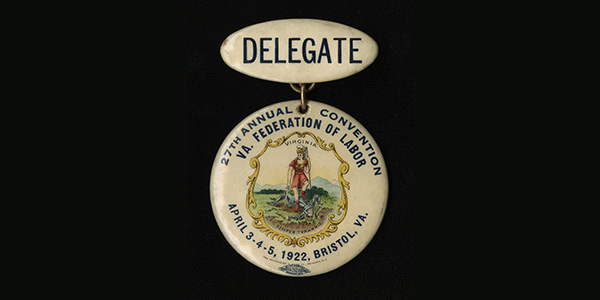Labor Day: More than a holiday

Showing through Sept. 5
Labor Day is much more than the unofficial end of summer or the start of the election season or a day for the beach and picnics and a Monday holiday making a three-day weekend. This display honors U.S. workers and recognizing the contributions of the American labor movement to improved working conditions, fair wages and benefits.
These images from labor history were chosen from collections in the Social Welfare History Image Portal, a VCU Libraries project presenting primary sources from 13 partner institutions.
You can read more about the people and organizations who dedicated themselves to supporting workers on VCU Libraries’ Social Welfare History Project. Learn about the interracial and gender-inclusive Southern Tenant Farmers’ Union, labor organizer and friend of Eleanor Roosevelt, Rose Schneiderman, the National Child Labor Committee, or the Flint Sit-Down Strike that transformed and empowered the United Automobile Workers.
The nation’s workers are the country’s chief asset–serving the nation in peace as well as war. This American Association for Labor Legislation membership recruitment bulletin asked “How WIll Our Country Protect This Army?” Adèle Goodman Clark papers, 1849-1978, James Branch Cabell Library, VCU Libraries.
“Workers of the World awaken / Break your chains, demand your rights…” Joe Hill, union organizer and labor folk hero
Songs of the Workers: To Fan the Flames of Discontent. Edward H. Peeples Collection, Special Collections and Archives, James Branch Cabell Library, VCU Libraries
The Equity Star A union representing live theatrical performers. In 1919 Actors Equity called the first strike in American theater history.
Image courtesy: Frances G. Spencer Collection of American Popular Sheet Music, Crouch Fine Arts Library, Digital Collections, Baylor University Libraries
American Federation of Labor Song “Dedicated to Mr. Samuel Gompers.”
AFL seal at center contains the motto “Labor Omnia Vincit” (Work Conquers All). Image courtesy: Frances G. Spencer Collection of American Popular Sheet Music, Crouch Fine Arts Library, Digital Collections, Baylor University Libraries
National Women’s Trade Union League logo
The National Women’s Trade Union League achieved legislation for an 8-hour workday, a minimum wage, and the abolition of child labor. Roberta Wellford Collection of Women’s Rights Ephemera 1915-1956, James Branch Cabell Library, VCU Libraries
Sweat Shop. Anti-child labor editorial cartoon by Thomas May Cartoons Magazine. Special Collections and Archives, James Branch Cabell Library, VCU Libraries.
Virginia Federation of Labor Convention Badge, April 1922.
Image courtesy: Virginia Museum of History & Culture, Virginia Historical Society
Girls Home, 502 W. Clay Street, Richmond, Va. A home for employed, self-supporting African American women in Richmond, Va. Adèle Goodman Clark papers, 1849-1978, James Branch Cabell Library, VCU Libraries.
Eight and one-half Million Women Workers! NWTUL pamphlet advocating for better working conditions, hours, and wages for women and girls.
Adèle Goodman Clark papers, 1849-1978, James Branch Cabell Library, VCU Libraries
Happy to be working in an office and not on the farm. Working Woman. Fred O. Seibel editorial cartoon, 1922. Frederick Otto Seibel papers, 1882-1968. James Branch Cabell Library, VCU Libraries.
Lorena Weeks with typewriter. Lorena Weeks was denied a higher paying position because she was a woman. Her case, Weeks v. Southern Bell, marked an important early legal victory in the fight against gender-based workplace discrimination.
Image courtesy: Sylvia Roberts papers. Newcomb Archives, Newcomb College Institute, Tulane University.
“They Shall Not Pass” cover cartoon by C. D. Batchelor. The Woman Citizen, June 9, 1917. A figure representing woman suffrage protects children from labor exploitation. Special Collections and Archives, James Branch Cabell Library, VCU Libraries
“Security of Employment” editorial cartoon by Gordon Grant. American Association for Labor Legislation advertising. A family stands under an arch in which the keystone (labeled “Employment”) is slipping out. If the keystone falls, the family will be crushed. Adèle Goodman Clark papers, 1849-1978, James Branch Cabell Library, VCU Libraries
The Doctor Looks at Child Labor. National Child Labor Committee pamphlet. “We would not permit the exploitation of a child that is precious to any one of us. Let us not, therefore, as citizens, tolerate the exploitation of other people’s children” (from cover).
Image courtesy: William Smith Morton Library, Union Presbyterian Seminary
Strikers March, Passaic Textile Strike, 1926. This work stoppage by more than 15,000 woolen mill workers in and around Passaic, New Jersey was the first Communist-led work stoppage in the United States. Image courtesy: American Labor Museum / Botto House National Landmark
Child strikers, Passaic Textile Strike, 1926. Children of Forstmann Huffman employees participate in strike. They hold signs reading “WE WANT MORE FOOD AND MORE CLOTHES” and “WE ARE STRIKERS CHILDREN WE NEED MORE FOOD.” Image courtesy: American Labor Museum / Botto House National Landmark
Categories Collections, Community, News